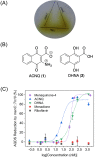An elusive electron shuttle from a facultative anaerobe
- PMID: 31232690
- PMCID: PMC6687433
- DOI: 10.7554/eLife.48054
An elusive electron shuttle from a facultative anaerobe
Abstract
Some anaerobic bacteria use insoluble minerals as terminal electron acceptors and discovering the ways in which electrons move through the membrane barrier to the exterior acceptor forms an active field of research with implications for both bacterial physiology and bioenergy. A previous study suggested that Shewanella oneidensis MR-1 utilizes a small, polar, redox active molecule that serves as an electron shuttle between the bacteria and insoluble acceptors, but the shuttle itself has never been identified. Through isolation and synthesis, we identify it as ACNQ (2-amino-3-carboxy-1,4-naphthoquinone), a soluble analog of menaquinone. ACNQ is derived from DHNA (1,4-dihydroxy-2-naphthoic acid) in a non-enzymatic process that frustrated genetic approaches to identify the shuttle. Both ACNQ and DHNA restore reduction of AQDS under anaerobic growth in menaquinone-deficient mutants. Bioelectrochemistry analyses reveal that ACNQ (-0.32 VAg/AgCl) contributes to the extracellular electron transfer (EET) as an electron shuttle, without altering menaquinone generation or EET related cytochrome c expression.
Keywords: ACNQ; Redox; Shewanella oneidensis; biochemistry; chemical biology; extracellular electron shuttle; infectious disease; microbiology; none.
© 2019, Mevers et al.
Conflict of interest statement
EM, LS, GP, MB, JC, EH, ED, CA No competing interests declared, JC Reviewing editor, eLife
Figures

























Comment in
-
Solving a shuttle mystery.Elife. 2019 Aug 8;8:e49831. doi: 10.7554/eLife.49831. Elife. 2019. PMID: 31393267 Free PMC article.
References
-
- Aulenta F, Maio VD, Ferri T, Majone M. The humic acid analogue antraquinone-2,6-disulfonate (AQDS) serves as an electron shuttle in the electricity-driven microbial dechlorination of trichloroethene to cis-dichloroethene. Bioresource Technology. 2010;101:9728–9733. doi: 10.1016/j.biortech.2010.07.090. - DOI - PubMed
Publication types
MeSH terms
Substances
Supplementary concepts
Grants and funding
LinkOut - more resources
Full Text Sources
Other Literature Sources
Molecular Biology Databases

